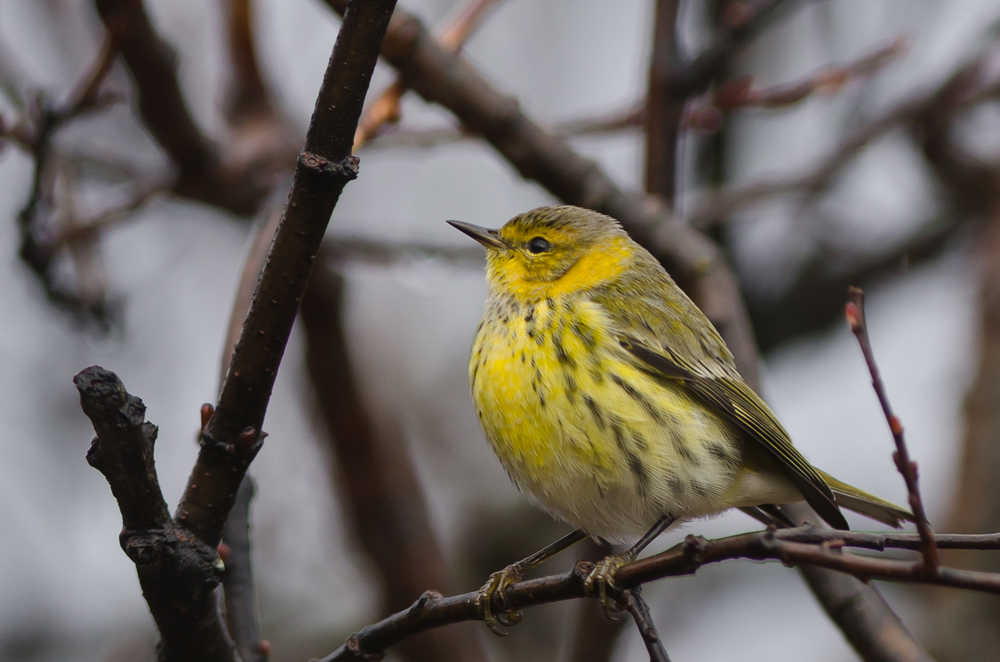It was like a scene out of the movie “The Big Year” starring Steve Martin, Owen Wilson, and Jack Black. Several hotshot birding friends decided to make a run to Seward after a recent storm to see what interesting birds might have been deposited.
At their second stop they popped into Benny Benson Lagoon and 3 of the 4 birders jumped out and began scanning the collection of gulls that assemble at the outlet of the lagoon. The congregation was feeding on dying Coho salmon. If there was going to be a rare gull blown in during the recent foul weather, this would be the ideal spot to find it. The fourth birder in the group decided three sets of eyes on the lagoon were likely enough, so he decided to scan the alder patch behind them that was unlikely to hold much of anything with no leaves and only a few insects coming off the trickle of water in the ditch.
A flash of yellow appeared and he was in business. He alerted the rest of the group to his find. Flitting in the grey wet branches was the first record of a Cape May Warbler for the Kenai Peninsula!
The Cape May Warbler is a fairly hardy little bird that breeds throughout the boreal zone in Canada and winters on islands in the Caribbean. I say it is hardy because there are many winter records of stray birds being found in the central and eastern U.S. into mid-January. These strays appear to be assisted by feeding on suet feeders which may allow them to “hang-on” a little longer.
The Kenai Peninsula is experiencing unseasonably mild temperatures this winter and this does have a benefit for birders, but probably not in the way you would think. Intuition would tell you that the warm weather might attract migrants to stay here. Maybe the warm weather is even attractive enough for birds that don’t normally live here to come and visit.
The reality is that birds are either blown astray by huge storms or they are pre-programmed to go the wrong way. The warmer weather just helps stray birds survive long enough that bird watchers have an opportunity to find them. Most of these strays are unlikely to actually survive the entire winter period, but that is part of the system built into their biology to allow each species to adapt to changing environmental conditions.
You can think of these vagrants as the pioneers. A very small portion of each population decides to go against what every other member is doing. Instead of heading south to the balmy climates of the Cayman Islands, these adventurers seek out untested areas. Like most early adventurers they meet their demise by encountering conditions unfit for survival.
OK, it may not be quite as glamorous as that — they may just be wired wrong and flew the wrong direction in trying to find Cuba. But as the climate or habitat changes, these birds find spots that are inhabitable and they become the wanderers that are able to make it and establish a new range for the species. Personally, I would pick the Bahamas over Seward in November, but that is just me.
The rest of the trip for our hotshot birding crew from Anchorage was quite fruitful. They found what appeared to be a first year “Kumlien’s” Gull which breeds in the Canadian arctic.
Then, in a residential area, they photographed a White-throated Sparrow. White-throated Sparrows breed throughout the Great Lakes Region and across Canada to within about 600 miles of Seward. Interestingly, individual birds have been found during winter in Homer, Seward and Kenai for about seven years in a row. It may be a matter of time before someone discovers the first breeding pair of White-throated Sparrows and extends the breeding colored portion of the range map to the Kenai Peninsula.
It is this constant ebb and flood of bird ranges and occurrences that makes studying and watching birds so fun and frustrating at the same time. When you look at a range map in a book, it is just a snap shot at the time of printing. Then when you think about our changing climate and the things that are happing here on the Kenai Peninsula, it is an exciting time for bird watchers to find something new. It may be the excitement of finding a common species like a Violet-green Swallow in September which has never been documented before.
If you are lucky and put your time in, you may find a new species for the Kenai like a Canada Warbler or a Rose-breasted Grosbeak. My guess is that vagrants of both species have landed on the Kenai in the past, but were never discovered.
If you see or photograph a bird you don’t recognize, call Todd Eskelin or Toby Burke at the Kenai National Wildlife Refuge for help with identification (907 262-7021). If you know what the bird is, enter it in eBird (www.ebird.org) to share your sightings with other birders.
Todd Eskelin is a Wildlife Biologist at the Kenai National Wildlife Refuge who has conducted research on songbirds in many areas of Alaska. Find more information about the Refuge at http://kenai.fws.gov or http://www.facebook.com/kenainationalwildliferefuge.

